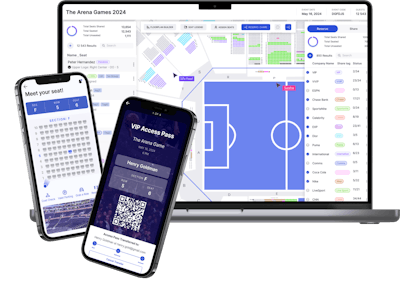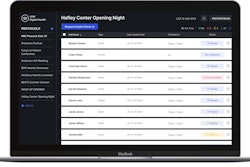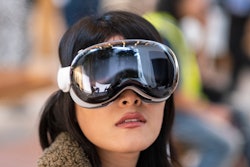
If you've ever managed a seating map for a major event, you know it's all about who's rubbing elbows with who. But it can be a huge headache working with multiple organizations behind the scenes to make sure everyone's happy with the floor plan. This is exactly where guest management platform VOW aims to step in for planners.
 Jennifer BrismanPhoto: Courtesy of VOW
Jennifer BrismanPhoto: Courtesy of VOW
This includes features like guest and group list and data management, invitations and communications, tracking RSVPs and data collection, real-time alerts and notifications, and (a standout to us) integrated venue maps and seating for up to 15,000 in a single view.
It also enables organizers to share views with collaborators outside the primary organizations (sponsors, studios, media agencies) who can also work alongside organizers inside VOW in real time with specialized views. VOW has worked with major brands like the Tony Awards; PFL-MMA; GLAAD Media; Character Media; Writers Guild Association; and others in sports, media, and entertainment.
"It doesn't just solve for fragmentation across tools—it solves for fragmentation across your team and stakeholders," Brisman says. We recently caught up with her to learn more about VOW's evolution, why the focus on seating maps, tips for using it, and more.
How did VOW evolve from a COVID safety platform to what it is today?
It was always a platform that aggregated people in our community to work together. Pre-COVID, VOW was called One Workspace. It was a collaboration tool where event profs could come together and work in real time. That's what it still is today, in part. When the pandemic hit, we learned that to be able to enter any physical space or gathering, small or large, people would have to be COVID-screened at scale.
And this pass that was on their phones, showing they were COVID clear, was the first real physical thing that people were touching in their hands to go to an event, other than, if you think about it, a ticket. And so organizers said to us, 'Hey, you've got these beautiful passes showing that thousands of people are COVID clear to go to this one event. Can we make them dynamic? Can we include other information about the event in the palm of their hands?'
 Photo: Courtesy of VOW
Photo: Courtesy of VOW
We intuitively knew we had to use this product as a wedge in the market to what was going to be next. We stayed tied to our customers and let them tell us what was needed. While we were not the primary tool that they were using, we were the most important tool they were using to fill seats and protect revenue.
As ticketed events came back and had private experiences again, we realized all these organizers were still moving in this fragmented way, between guest list management tools, seating software tools, email, SMS, or pen and paper—you name it, they were doing it.
Everything you do for a live event—especially a private, high-touch event—is about championing the guest experience and magic, and that's really where VOW came into play. Our platform, which is called VOW Go, really speaks to owning the end-to-end guest experience at scale and allowing event organizers of any size to automate and synthesize the guest journey—eliminating fragmentation, eliminating antiquated systems, and getting back to what matters most.
Talk a bit more about that fragmentation and what exactly VOW is trying to solve for planners
It's likely your guest list is still in one place, and your seating and venue maps are in another place. Those seating maps are representative of really important data that other people need to know. You have the groups that you're communicating back and forth with—sponsors, stakeholders, studios, marketing agencies, customers—who have to champion guests in seats. And so it's not just fragmentation across your team moving between different platforms. There's also fragmentation across everyone you're collaborating with moving between different platforms. It really becomes this time suck.
VOW is the first end-to-end platform for private live events that puts everything under one roof, and all the tools talk to each other, and they do so in real time. So if you make a change in your seating software, you make it in your guest list, and it's made subsequently on your ticket. So those things are integrated along with email and other important information.
Our seating software is the fastest on the market today and the most responsive in terms of scaling in, scaling out, and actual tasks within it. You can have up to 350 people working in our platform in real time with permissions similar to Google like editor or viewer only. And so it's solving for fragmentation across tools, but it's also solving for fragmentation across teams.
VOW also solves immense pain across groups as you're communicating with them. Those groups—like sponsors or marketing agencies—need to have information, take tasks, and do things at a certain scale for them. In VOW, they can see the information they need to see in a way they need to see it. And everything that everybody does materializes in real time.
 Photo: Courtesy of VOW
Photo: Courtesy of VOW
Why the focus on floor plans and seating maps?
When we went to build VOW, we really thought there was a universe in which we would partner with an existing seating software. But I found that they were very legacy in their field. They were daunting. There were no efficiencies in them. They really wanted to be CAD-like and truly emulate the room, like the walls in the right place, the windows, where the plugs are.
The softwares that do this are absolutely amazing—but that's not the pain. As an event organizer, I felt it's a very rare job where you need that level of detail. And that level of detail is really just to make sure that those tables are in the room. But I can tell you, as someone who's done millions of dollars' worth of events, it has never mattered.
The real pain is the back and forth with the groups around where they're sat, who's got to have elbows touching each other, and the real pain is getting this stuff done quickly. There's no glory in moving a plug or a video village one inch to the left. In the majority of live programs—even a 7,000-person live event at whatever city center featuring headline entertainment—it does not matter.
Our scale is about really big galas, award shows, opening nights, performances, and variety shows. Our scale is about conferences and summits and exhibits where scale matters because you have to move around the puzzle pieces like a game of Tetris nonstop. You have to build floor plans, change them on the fly, move people's seats—it is a game of Tetris, and we have the most responsive platform on the market for up to 15,000 seats that's fully integrated. We just found a different pain point that we think matters more to our community, and so we focus on that.
What tips would you give to a new VOW user?
It would be the same for any event technology. Most businesses only use about 10% of their SaaS [software as a service] or 10% of the actual software that they're using. What I would say is important to me is that they use all of it or most of it. In VOW, we offer professional support on demand and guest support. I think it speaks to our ethos as a company in terms of how we think about our customers. What they should think about when they're using the technology is, 'How do I lean into VOW to use all of it?' That's what we hope they'll do.
What do you think is the biggest thing impacting event tech right now?
I would say it's probably in event marketing. I think the softwares that have emerged as leaders, that may or may not be part of the event ecosystem, are really doubling down on AI for event marketing. That's been really interesting to watch. And I think that will continue to be interesting to watch, especially for things like large festivals, independent film festivals, etc., where you really need to get boots on the ground, you really need people to come, and it's not something you can sell virtually.
It'll be really interesting to see how AI-driven event marketing platforms lean in, not just for data, copy, and messaging, but really much more than that. It'll be interesting to see who stands out from there.
This interview has been edited and condensed.



















